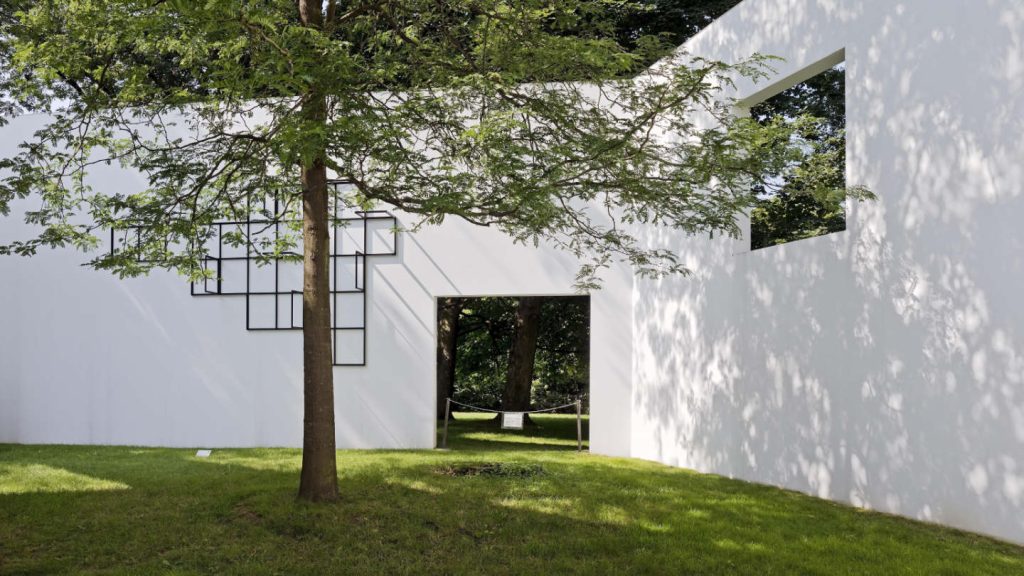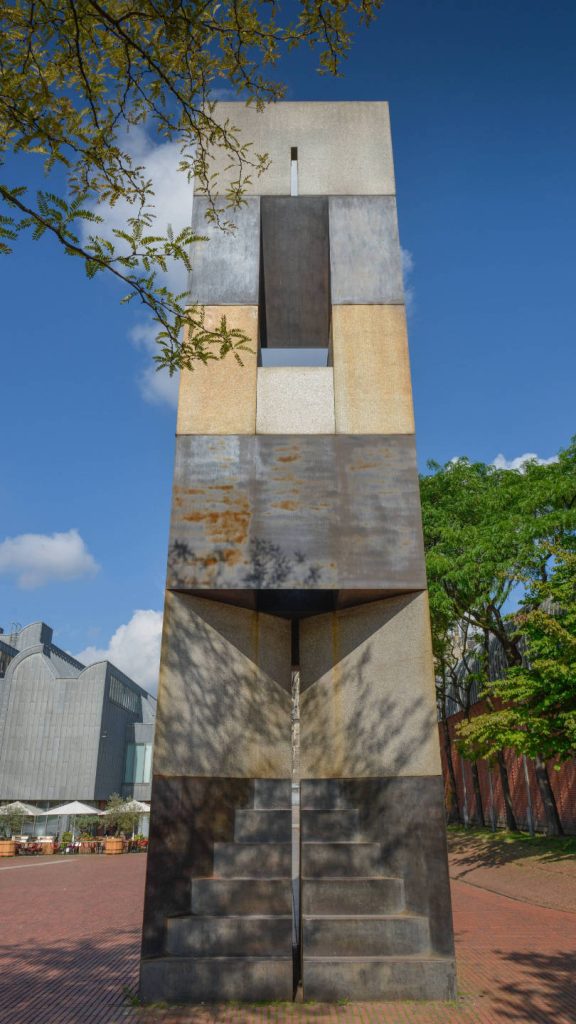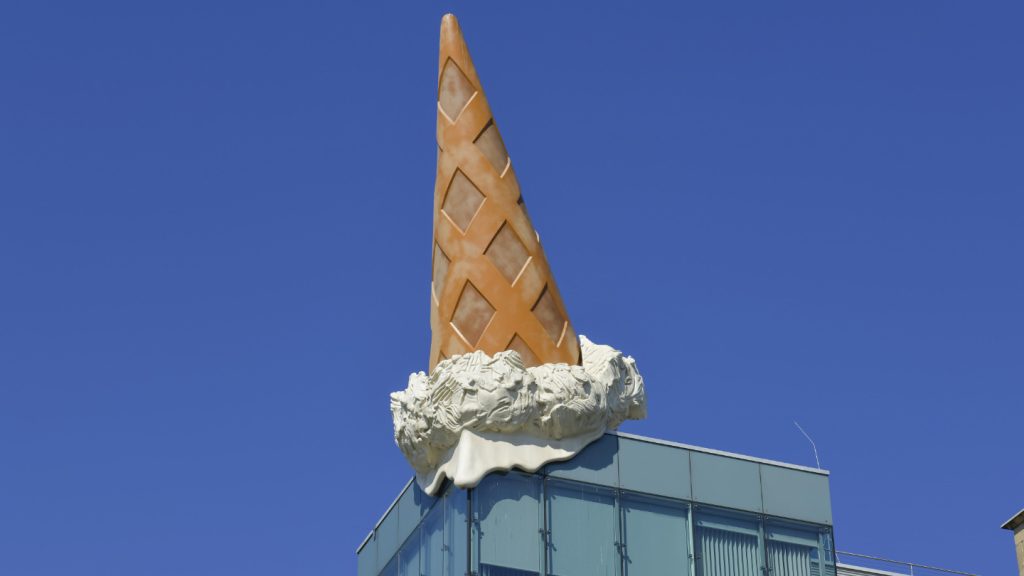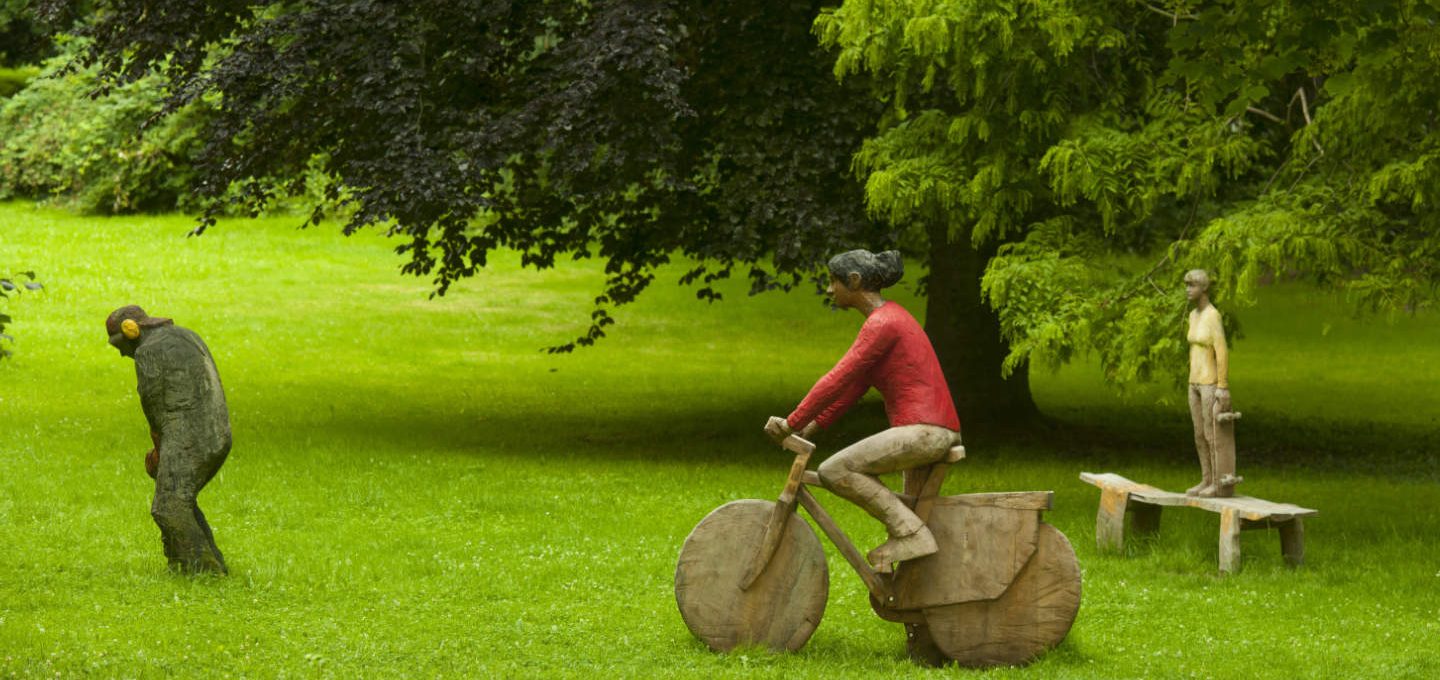Our bike ride through Cologne kicks off in the north, on the eastern side of the Rhine. You take the S-Bahn train to Köln-Stammheim, exiting onto Dünnwalder Kommunalweg, which you continue along towards the B8. This then becomes Stammheimer Ring, which takes you through almost village-like idyllic scenery to Schlossstraße, ultimately leading past cute houses to the portal of Stammheimer Schlosspark, guarded by two stone lions.

The “Schloss” in Schlosspark means “palace” or “mansion” but you won’t find either here. There was a noble residence here from the 12th century onwards but the building constructed in the 18th century didn’t survive the bombing of the Second World War. Today, the sculpture of the former portal is a reminder of the building that once stood here. It’s the work of Herbert Labusga, who helped found the Skulpturenpark here in 2002. New sculptures, installations and other works of art are added every year and there are now more than 70. The park itself was designed in the 1830s based on the English landscape garden style. With 200-year-old trees and awe-inspiring contemporary art, it’s a wonderful place to take a leisurely stroll.
More sculptures await at our next art stop

Enough of being on your feet? Back on your bicycle, it’s straight ahead all the way, along the Rhine, past modern high-rise buildings and former harbour complexes. You cross Zoobrücke bridge to the western side of the river for our next art stop, Skulpturenpark Köln. This place, which opened a good 25 years ago, offers an opportunity to admire art outdoors, with an exhibition called “KölnSkulptur” that’s curated anew every two years. Currently, works by big names such as Anish Kapoor and Mary Bauermeister are on display. Bikes have to stay outside.
Reunited with your bike, you continue along the riverbank, heading towards the cathedral. Pass beneath Hohenzollernbrücke bridge and then upwards on the right towards the Philharmonie. This brings you straight to the next public work of art: Ma’alot (1986), by Dani Karavan, which takes in the whole of Heinrich-Böll-Platz. “Ma’alot” is Hebrew and roughly translates as “step”. The most evident steps in this work are the six steps of the almost 11-metre tall sculpture near the Hohenzollernbrücke bridge. Other sculptures and the railway tracks embedded in the cobblestones are a nod to the nearby central station. The pattern in the ground in front of Museum Ludwig‘s café is also exquisite to see.

Is that a car up there on the roof?
You might have to push your bicycle for the next bit of our cycling tour of Cologne. Depending on what they’re doing at the nearby construction site, you’ll pass the gothic cathedral either on the left or the right and then ride on via Trankgasse, Komödienstraße and Zeughausstraße to a real high-light. “Is that a car up there on the roof?” I hear you say. “A car with wings?” Yep, that’s right. The thing you can see shining from on high is a golden Ford Fiesta. Officially titled “The Golden Bird”, it was created by performance artist HA Schult for a temporary exhibition in 1989 and moved to the roof of the Zeughaus museum in the city centre in 1991. If you want to get a really good view of it, cycle on a little and turn around when you get to the junction with Auf dem Berlich street.
We stay on this street as we make our way towards the next stop: Richmodishaus. Here, our gaze wanders upwards again but this time to two horse heads looking down from a tower instead of a car on a roof. The sculpture, created by Wilhelm Müller-Maus in 1958, is a reference to a Cologne legend. The story goes that in the fourteenth century, Richmodis, the wife of a member of the city council, was taken by the plague. Or so they thought. Having awoken “from the dead”, she returned to her home where she was mistaken for a “ghost” and only the servants dared open the door to her. When they told her husband who had been knocking at the door, he apparently proclaimed, “Never! It’s more likely that my horses will climb up on the roof!” With which, several horses clopped up the stairs to the tower and looked out of the window.
Pop art by Claese Oldenburg at Neumarkt
On the subject of interesting roof decorations – pedal on a little more and you reach Neumarkt. On the left, you’ll find an “ice-cream cone” by pop-art great Claes Oldenburg and Coosja van Bruggen. The colossal “Dropped Cone”, weighing in at three tonnes, landed vanilla scoop down on the roof of the Neumarktgalerie shopping centre in 2001. Why? As so often in Cologne, it seems the cathedral might have something to do with it. According to the artists, the work is intended as a homage to the cathedral’s spires and the city’s skyline. And since the cathedral actually has two spires (though only since 1880 but that’s a different story), there were supposed to be two cones. So why aren’t there? It seems we’ll be wondering about that for some time to come.

To the south of Neumarkt, we see the comforting message “Don’t Worry” glowing from the spire of Saint Peter’s Church. This neon sign in various languages is the work of Turner Prize winner Martin Creed. It’s worth taking a look inside the church too. As well as services and concerts, it has developed a reputation as an excellent venue for contemporary art, with rotating exhibitions sharing the spotlight with a genuine Rubens (“The Crucifixion of Saint Peter”), thanks to the art-loving Jesuit priest Friedhelm Menneke and his idea of an art hub, Kunst-Station Sankt Peter. Hallelujah!

0 comments on “Exploring Cologne’s open-air art by bike”